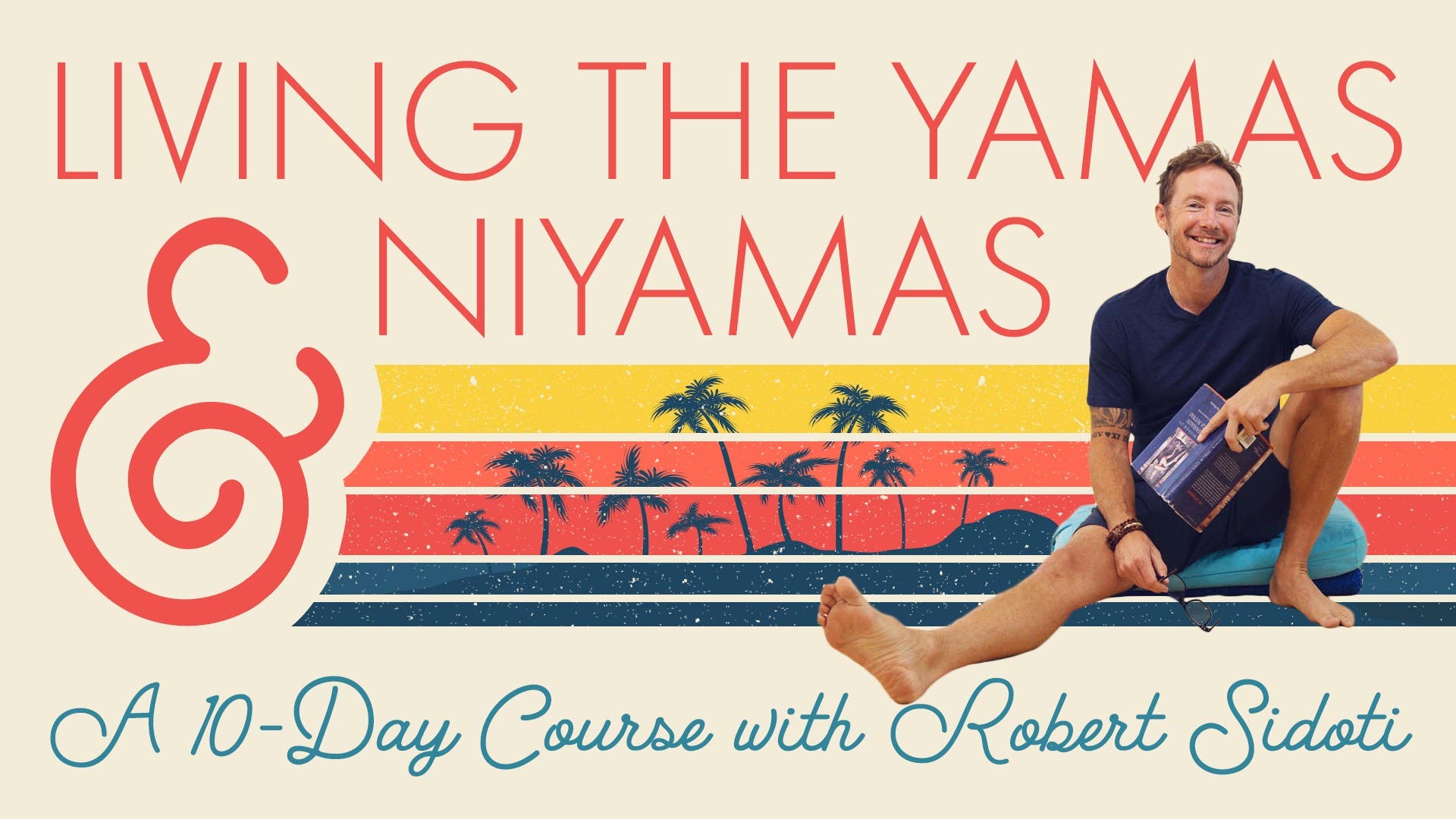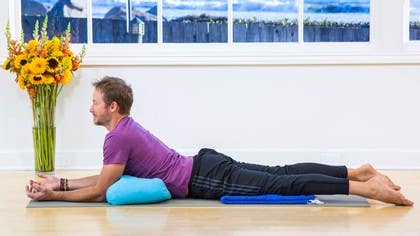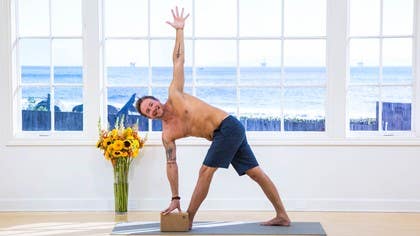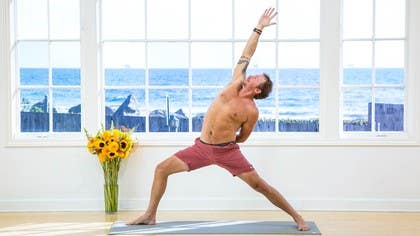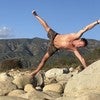Description
About This Video
Transcript
Read Full Transcript
Hey there, welcome back, nice to see you again. This is the fifth yama, this is aparigraha. This is all about holding on, this like non-grasping or clinging or holding and letting go. So how do we see that, how do we view that? The way I can give a couple of suggestions would be, you know, this hoarding and holding on of things, just physical objects, right?
You might have a room that's just filled with stuff you don't really need, right? I know I have a closet filled with t-shirts, like t-shirts that I have not worn in, I don't know how many years, and every time I go in there to like get rid of them, I try it on. I'm like, ah, I might wear it again, I never wear it, but I'm just holding on, it has some sort of weird sentimental value. So physical objects in your home, in your car, in your space all around you, maybe there's some like letting go, right? What other options are there?
There's the letting go, give a personal one, right? And if there's any parents out there that have gone through this or who will go through this, you know, I have a 16-year-old son and starting to drive now, and you know, he's a junior in high school, and I'm seeing and going through this process of letting go, watching him sort of gain more and more, it's a beautiful, amazing thing, there's nothing real negative about it, but I find myself like wanting to pull back, find myself looking at old photographs, you know, like, aw, you know, so this is a real, real life practice for me, and so where are those real life practices for you? What are you holding onto, you know? Is there some anger, you know, some resentment, some grieving, something that you're almost holding as like a, well, I don't know why you would be holding onto it. I know why I'm holding onto some grief of my mother passing, right?
But it might serve me to let some of that go. So this can be a big one, and it could kind of free us up in some way, right? So what are you holding onto, what are you grasping onto, and even in the practice as we move through this style of movement, all right, you come into these poses sometimes and you want it to be a certain way, or you start to feel this gripping and tension. So this practice is going to be like a yin style approach with some restorative options, okay? You can see I've got a bolster here, got a blanket back here, take the time to get those tools if you've got them, if you don't have them, substitute whatever you can get.
And I just want to encourage you, as best you can, come into this practice with full permission to let go, right, to let go. And just one more thought, you know, we hear that a lot in the yoga world, you know, just let it go, man, just let it go. But maybe it's not letting go. Maybe you just create, which is what I've learned to do with certain things, is create a different relationship with it so that I can actually soften around it and not hold onto it. Does that make sense, right?
So I don't expect you to like let it go, man, right? But just kind of look at different things and what your relationship is with it, okay? This is work, right? Want to feel better, we want to let go of some stuff, let's spend some time doing that. So without talking and chatting up anymore, find your mat, your comfortable space, right?
Whatever you need to do to drop in, right? This is a drop in, chill out type of a vibe, okay? So the first practice, first physical asana will be a child's pose. So we're going to hold, just so you know, we're going to hold these for roughly four minutes, give or take, you know, so let's do it. So we're going to bring the bolster or a pillow or something out in front of your mat.
And so our knees are comfortable, holding a pose for a while. We don't need to be suffering in any area of the body. So bring the knees onto the blanket, create the, you know, the idea with these yin postures is to create a passive stretch so that you can sit in the pose comfortably and release, release, release, okay? So knees together wide, probably wide so that you can breathe. Walk the arms forward onto an elevated bolster or pillow, maybe even slide it back a lot so that your forehead rests.
Pass your arms, what I'd like you to do as we integrate into this posture is make decisions on how you can be comfortable here, all right? So let's begin this posture with a breath in and a breath out, we arrive in the shape. This is where we have choices in which we want to kind of approach this, this shape anatomically like in our muscles and fascia and tissue, you just kind of tune into those areas that you feel like you're getting your stretch, the release physically and you tune into that for a few moments. Take a few very conscious, relaxed, fluid breaths and then going into this pose and every other pose, feel free to adjust and adapt at any moment you need. Relax your shoulders and once you, as I've encouraged already, you found your breathing and you found a threshold of stretch or intensity that is very doable.
If it's interesting to you at all, start to draw your attention into that space of where you might be holding and where you can loosen the grip a little bit. Maybe you're that person in your relationship and where you have to hold on and be in control because you feel like maybe if you're not, everything will fall apart. Maybe you can learn to let go in certain small areas so you gain that trust, the trust that if I let go more and more, everything still runs well and works well, maybe even better. What's helpful for me when I'm working on this stuff is, this specific type of work, is using the exhale, like attaching a visual aid, like there's a visual aid or a feeling, something I'm wanting to kind of release and let go to the exhalation. You can see it and feel it working toward departing.
Very so often scan the body, scan the body for surface tension and stress. You breathe in, you fill the front side of the body, that'll actually, if you bring your attention to it, it'll fill the back body as well so you can feel your low back, your mid back, your rib cage kind of expand as you breathe in and breathe out. If you found a groove and you'd like to stay here, feel free, we're gonna slowly move into our next pose. So come on out and you'd like, okay, what you can do is you can keep the blanket right where it is and even the bolster where it is and we'll move into Sphinx pose. This will be ideally a passive backbend, heart opener.
So you can come forward onto your forearms, elbows right in front of the bolster, hips down on the blanket, untucking the toes. So as we did in the prior shape, figure out what's most comfortable for you. So the physical shape is important. So you don't want to have any agitation or any nuisance, right? Legs are long, toes are pointed back, elbows are placed underneath the shoulders or slightly forward to reduce the intensity in the low back.
Now what might be helpful for you is find a very comfortable head position, might keep it up or if it feels good, you can drop the head and relax the shoulders. If you feel tension in your low back, but it's not enough tension for you to adjust the posture, use your exhalations to soften your butt, soften the glutes and the hold around your rear because sometimes that'll kind of like create tension in the low back. Soften the low back, the mid back. Open all the facial muscles, your eyes, and if you can drop back into that full permission to be in this slow pace, finding these moments of potentially, it's not always, but this sweet stillness. There's a little bit of effort in the arms to keep you up.
One option, I'm not going to use it, but if you do have a block nearby and you'd like to place the forehead down, you could put the block on the highest level and place your forehead down onto the block. You can lick the lips a little bit, like kind of sometimes we can get a little dry around the mouth and the tongue, the roof of the mouth. Come back into the contemplation of the releasing, and what am I holding onto? And like anything, you know, for success, you start small, you start with small things like for me. I'm going to give away five t-shirts.
This type of practice can be very like soothing and nourishing for the nervous system. So there's a trust, this underlying trust that you can bring to this type of practice where you know there are good, solid, real health benefits. Okay. I think all good things we must move on. Okay.
So let's move the bolster all the way forward. We will revisit. So you can leave the bolster up at the front of the mat. I'm going to leave the blanket where it is. If you'd like to move your blanket or adjust it, please do so.
This one here in the yin practice is called broken wing, right? So we're going to bring the left arm of the hand straight out from the left shoulder. The right hand is where you'd normally have it for like a cobra or upward dog, just to give you that rolling effect to help assist you in the rolling over onto the left shoulder. Now about halfway over, what I want you to feel for is like, oh, I can get more stretch through the shoulder and chest on the left side. The right foot is either resting on the left foot or right behind that left knee.
Now I could put my head down and feel pretty good, but this practice is about finding more comfort and more support. So I'm going to actually bring that bolster back into play, place the head down and find more comfort, position your legs in a way that you're not really having to focus on them too much. You could even bring the right arm up and back to your low back. If you have crazy flexibility or mobility, you can reach the right hand to the left hand. I'm nowhere near that.
So I'm going to place it at my low back. And just as before, get the physical shape, get the threshold of intensity. Work for you and begin the softening and you begin the work. So parigraha, non hoarding, grasping, clinging, what can I release, free me up and free myself up of thoughts of what I, of these expectations I had of myself, certain times of my life. So right about now, starting to get this really interesting, I've had it before, but there's this tingling in the fingers, the right hand and the left hand.
So if you're having any of that in any of these poses, it's pretty normal. So let's try the other side now. Pay attention to the exit in these postures after being there for so long. We even pause for just a brief moment, head facing down onto stacked hands, feel that post stretch sensation in the left arm and start to build it on the right side now. The right arm reaches out, slides over.
Remember the initial hit, you probably have more space. So on your way over, slide that right hand over a little bit more. One side's going to be probably a little tighter than the other. I say that because I'm noticing that on my right. Okay.
Left hand is there to support you. Place the left foot, left leg somewhere where it feels, you know, for me, I can place it on the other side of my right knee and I'm getting this kind of extra little hip opener. So that might be interesting to you, might be too much too. So move away from that if it's too much. We can use the bolster again to place the head down.
Make sure to set yourself up so you feel that stretch. You feel like there's, you know, it's really important, I think, you know, when we come into these shapes that there is that element of work being done on the body. So I feel personally, my shoulder and chest getting this really nice, very effective stretch. So are you able to find that? Breathe into that space, contemplate through the exhalations, right?
The letting go, the freeing yourself of the holding. Like anything, it's not going to happen with one breath, it'd be silly to try to convince you of that. It just doesn't happen, right? I can't remember who it was, but it's a nice quote about, you know, when you create a trail in the woods, you have to walk it over and over and over and over again. So same with like creating new patterns, new thought patterns, new movement patterns.
There's a new training, there's a retraining. Take another breath here, exhale everything out, feeling satisfied, and we roll out. Stack the palms again. Take a deep breath and rest the forehead on the stacked palms. Okay, so we move on to the next, which is puppy pose.
So here, this is a back bend, heart opener, kind of a thing. So knees on the blankets, the blanket, or blankets if you've got multiple blankets. And puppy pose, we keep the hips up over the knees. For this one, you know, you can 86 the bolster and walk the hands out like so. Head toward the mat, chin toward the mat, heart melting toward the mat.
We're going to use this today as an option. I'm going to bring my elbows. So maybe you bring your elbows to the bolster or the pillow or whatever you've got. Palms pressing together. And then you push the chest back and down toward the floor.
Forehead resting on that bolster, start to feel the intensity in the shoulders and keep the palms pressing together up top, behind the head, or even the palms resting at your upper back and shoulders, shoulder blades to encourage that softening there. You can take your elbows a little wider to create some more space. Let's enter with a flushing kind of exhalation. So breathe in, breathe out, let it go, soften the entire body. You hold the shape.
Breathe in three or four seconds, breathe out five to six seconds. Looking to extend the exhalation. It's a simple action, not always easy actually, but it is a simple action with a big benefit. The benefit being that sort of induces this like feeling of relaxation, feeling content and calm. Keep feeling free to make the adjustments.
The body's going to open or it's going to get a little bit fatigued. So if it opens, create more space for it to drop in. If it gets fatigued, adjust accordingly. Soften the heart, that whole heart space relaxes toward the floor, you can hold a lot in that space. Let's take three more breaths together here.
Exhale as fully as you can, exhale, let it go, inhale and exhale. Maybe this one is somewhat audible and it feels good for you to really let it go. Breathe in, exhale, sigh it out a little bit, so nice. So respect the shape you've just been in for a little bit and maybe push back into a child's pose and we'll transition to the next. Let's move the bolster out of the way for a moment.
You may actually want to use it. We're going to do this half butterfly. So its left foot draws into the right thigh, right leg is straight out. Now this isn't in my mind about getting the deepest forward bend you can get. You may be completely content sitting upright with a slight bend in the knee.
You could put the bolster underneath the back of the knee. That puppy pose gave me some hiccups. That actually feels really nice. So you've got options here. You can stay upright.
We can kind of lean into this with a lengthened spine, come forward and hands rest on the bolster or the ground or your leg. Or what might feel nice also is to kind of like round passively into the desired space. Let the head relax, trust the breath. Relax your shoulders. Let go of any idea of what you think the shape should look like.
Breathing in comfortably. Breathing out comfortably. You may notice with this like not forced approach, the body actually is a little bit more available and tends to soften and release kind of like welcoming you into new space. The more we force mentally, physically, the body will tend to push away. These types of practices are so nice because it gives you that time to cultivate real relationship with the body.
Real intimacy with the moment, with the breath, with the feelings and the body and the mind. Let's take this into the next side. So roll up if you're down. You could take a little counter pose, reach the hands back behind you, pull the shoulders back, chest up. Okay, so let's set it up on the other side.
Extend your left leg out, the bottom of the right foot to the inner left thigh. And again, I really personally love that feeling of support underneath the back of the knee. You're sitting on the edge of the blanket. So to position the pelvis forward, okay. So find that shape once again, you kind of sit upright and that could be totally enough.
Moving forward with a flat back, that could be a good spot. I'm going to move into what I personally prefer is chin drops down and I begin this breathing process that is calming and relaxing so that my body will receive that energy from me and maybe soften and create new space for me to approach. So I'm going to breathe in and breathe out with me as you move into your shape. Land where you land. Always rest gently on the leg or the bolster.
Relax the effort around the neck. As I cue you earlier on in the practice, always looking, kind of scanning around, seeing where you find that habitual hold or holds where your body just in that habitual way tenses up. A lot of us have it around our shoulders, neck, forehead, jaw. With this type of work, you know, we're not looking to get anywhere. This isn't a means to get anywhere.
This is simply to arrive in exactly what is and let it unfold, releasing the grip in the hands. Okay, we can come all the way back up. Let's back behind you once again. Open up the front of the body. Okay, we'll do full butterfly now.
So bottoms of the feet come together and you push the heels away from the body. Now what could be helpful is if you have blocks, you can place them underneath your thighs. You can use a pillow as well. That'll just help you not have to hold here, okay? I feel relatively comfortable here, so I'll go without.
This is one of those examples of the shape where it's like, this is simply how I'm built, right? The shape of my hips. Your hips might be completely different, not right, not wrong, but it might be a lot harder for you to sit. So you're going to sit a little bit more upright, okay? Options again, upright, hands back behind you, forward with a flat back.
Or my personal favorite with this type of practice is this kind of rolling, kind of holding gently inward. The breath is like this, like guide, it's in front of you, and as you're going into this space, the breath is kind of clearing, clearing space for you to arrive comfortably. If you have blocks or a pillow or bolsters, anything you'd like to place your forehead up on, your stack, your fist, your forehead could rest on your fists, but again, stay in that same kind of similar vibe of not pushing. You don't want too much intensity, it's passive. And this can be a very, I'll just acknowledge that right now, it can be a very difficult practice, finding that the ability, the interest and ability to sit with yourself, so if we are just filled with kind of negativity and frustration, it's going to be hard.
So take the time to witness the thoughts, what kind of thoughts dominate each and every given moment. It's like, you know, if you're going to have a gathering, you're going to invite people you want to spend time with, if you're going to go somewhere, you want to surround yourself with things that you like and enjoy and you want to see, make you feel a certain way. So same with the thoughts, if you have thoughts that are not serving you, don't give them the time of day, that way you can sit a little bit more comfortably, maybe have some positive, more worthwhile thoughts to hang out with. Taking our exit out, okay, I'm going to work in two, so it's kind of hard offering this, me speaking to you on the other side here, kind of hard offering this because I'm getting in my own little zone too, so to catch myself, this is real, this practice is almost more intense in a beautiful way than some of the other more active practices that we've been doing together, so I just thought I'd share that with you. This next posture requires the bolster and maybe even the blanket, so let's build it, this is a twist, so what we'll do is set it up so that you can see, you want to place the bolster lengthwise, kind of like on the mat, toward the front of the mat, so place your right hip up against the bottom end of the bolster, okay, create the leg shape that supports this twist here, so you've got to make sure, maybe the left heel comes in closer to the seat, untuck the back toes, top of the foot grounding, that could feel good.
From here, like any other spinal twist, we want to enter this lying face down twist with length in the spine, so sit up tall, rotate to the right, I'm going to grab the blanket, place it so that I have a little more height, rotate, be about one minute here on the right side, so come on down, you can bring your forehead straight down, your right cheek or your left cheek, whichever one is most available, enter with an exhalation, get a nice hold on the bolster, adjust the legs as you need, and let yourself completely be supported by the shape that you have set up for yourself. It's more challenging to breathe, so acknowledge that, adjust for it. One more breath here, and exhale, release, let it go, push up, okay, nice. So what we'll do is just take this, take it to the back side of the mat, place the left tip up against it, the bottom end of the bolster, create the leg shape, lengthen up, rotate, get that spinal twist, keep the spinal twist as you now walk your hands forward alongside the bolster, breathing along the way, right, like before, exhalation kind of clears the way for your landing, wherever your landing might be, right cheek, left cheek or even forehead. Find comfort, stay with the experience, it's one of the harder things about this type of practice is actually staying, and we generally want to wander off into maybe some unnecessary thoughts, it's not productive, adjusting as you land, the body's going to open more, so you adjust, land in a new space, soften with the breath, let's take one more breath here together, exhale it all out, and mindful of the exit, okay, now here we're going to move into relaxation, so give you options, I'm going to fold the blanket up, this is where potentially your head or my head will go, spin around, so this is the first option, your low back and butt up against the bottom end of the bolster, and roll down, situate the blanket in a way where it feels really supportive on the neck and head, bottoms of the feet together, hips open, blocks under the thighs if you'd like, or legs straight, if none of this works for you, you want to lose the blanket, lose the bolster, lie down in final relaxation however you'd like, I will demo this and be in this shape for the duration of our relaxation, so to complete this practice, we'll move into final relaxation, beginning with one very fulfilling, meaningful breath in, open the mouth and exhale it all out, relax your arms, close your eyes, maybe even cover your eyes with something lying around you, a shirt or a sweater, blanket, this is the shape where I encourage you to let go of all thought, all contemplation, allow the breath to roam freely in and out on its own, lie in the comfort, the space that you've now cultivated and created for yourself, that's a lot of work, minute by minute by minute, opening the body, relaxing through the nervous system, releasing whatever you may have been releasing, and now lie peacefully as calm as you can in a well-earned space.
So, treat this relaxation as a gift. Gift to yourself, to yourself, from yourself, well-earned. If you're in the groove and you want to stay, as all other practices do what you feel is best for you, relax as long as you'd like. If this is evening and you're going to move into bed, ah, lucky you, that sounds nice. All right, I'll come up to a sitting position. Oh, man, I cannot like express to you how nice that is for me to be able to share that with you. So, I have my own things going on, my own things I'm looking to release and work with. I'm hoping that this concept of a parigraha, you know, works for you, and this isn't something that happens in one day or one minute, right? Keep practicing. Where am I holding? Where am I holding? What can I let go? So, as always, always, always, always, thank you, thank you, thank you, such a gift being here, thank you, namaste.
Living the Yamas and Niyamas
Comments
You need to be a subscriber to post a comment.
Please Log In or Create an Account to start your free trial.

